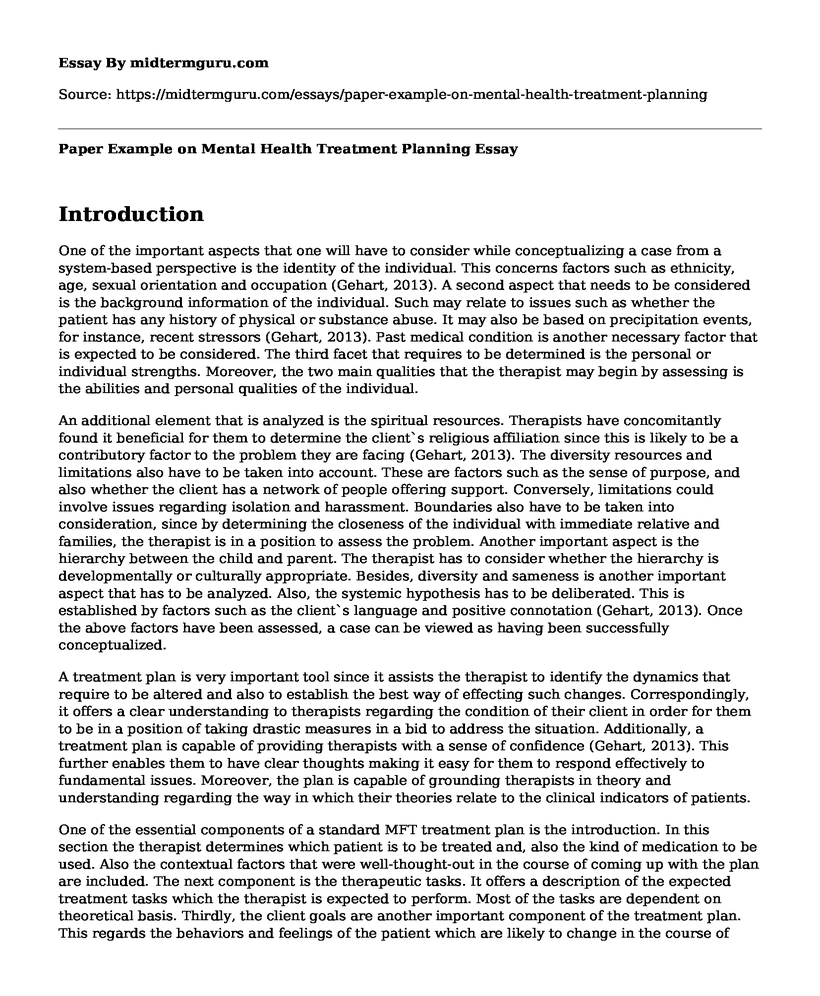Introduction
One of the important aspects that one will have to consider while conceptualizing a case from a system-based perspective is the identity of the individual. This concerns factors such as ethnicity, age, sexual orientation and occupation (Gehart, 2013). A second aspect that needs to be considered is the background information of the individual. Such may relate to issues such as whether the patient has any history of physical or substance abuse. It may also be based on precipitation events, for instance, recent stressors (Gehart, 2013). Past medical condition is another necessary factor that is expected to be considered. The third facet that requires to be determined is the personal or individual strengths. Moreover, the two main qualities that the therapist may begin by assessing is the abilities and personal qualities of the individual.
An additional element that is analyzed is the spiritual resources. Therapists have concomitantly found it beneficial for them to determine the client`s religious affiliation since this is likely to be a contributory factor to the problem they are facing (Gehart, 2013). The diversity resources and limitations also have to be taken into account. These are factors such as the sense of purpose, and also whether the client has a network of people offering support. Conversely, limitations could involve issues regarding isolation and harassment. Boundaries also have to be taken into consideration, since by determining the closeness of the individual with immediate relative and families, the therapist is in a position to assess the problem. Another important aspect is the hierarchy between the child and parent. The therapist has to consider whether the hierarchy is developmentally or culturally appropriate. Besides, diversity and sameness is another important aspect that has to be analyzed. Also, the systemic hypothesis has to be deliberated. This is established by factors such as the client`s language and positive connotation (Gehart, 2013). Once the above factors have been assessed, a case can be viewed as having been successfully conceptualized.
A treatment plan is very important tool since it assists the therapist to identify the dynamics that require to be altered and also to establish the best way of effecting such changes. Correspondingly, it offers a clear understanding to therapists regarding the condition of their client in order for them to be in a position of taking drastic measures in a bid to address the situation. Additionally, a treatment plan is capable of providing therapists with a sense of confidence (Gehart, 2013). This further enables them to have clear thoughts making it easy for them to respond effectively to fundamental issues. Moreover, the plan is capable of grounding therapists in theory and understanding regarding the way in which their theories relate to the clinical indicators of patients.
One of the essential components of a standard MFT treatment plan is the introduction. In this section the therapist determines which patient is to be treated and, also the kind of medication to be used. Also the contextual factors that were well-thought-out in the course of coming up with the plan are included. The next component is the therapeutic tasks. It offers a description of the expected treatment tasks which the therapist is expected to perform. Most of the tasks are dependent on theoretical basis. Thirdly, the client goals are another important component of the treatment plan. This regards the behaviors and feelings of the patient which are likely to change in the course of treatment. Theory-specific language is utilized in this case (Gehart, 2013). The fourth component is interventions. The section offers a definition of the interventions that need to be made in order to attain each of the specified goals. Finally, the client perspective is another component of the treatment plan which offers a description of the agreement made between the client and therapist in regards to the plan that has been outlined.
Reference
Gehart, D. R. (2013). Mastering competencies in family therapy: A practical approach to theories and clinical case documentation. CA: Brooks-Cole, Cengage Learning.
Cite this page
Paper Example on Mental Health Treatment Planning. (2022, Sep 26). Retrieved from https://midtermguru.com/essays/paper-example-on-mental-health-treatment-planning
If you are the original author of this essay and no longer wish to have it published on the midtermguru.com website, please click below to request its removal:
- Essay on Challenges of Older Adults Experience in Managing Their Health
- Research Paper on Latino Mental Healthcare
- Paper Example on Mental Health Treatment Planning
- Ethical Theories - Assignment Example
- Essay Sample on Attention Deficit Hyperactive Disorder: Therapy vs. Medication
- Personality: Neuroticism & Biblical Character - Essay Sample
- Moral Philosophy: Examining Right and Wrong in Existence - Essay Sample







